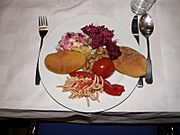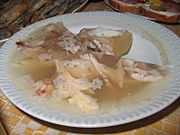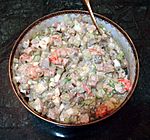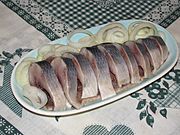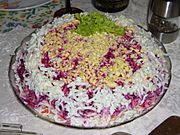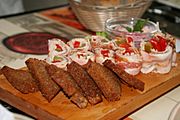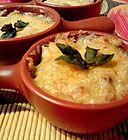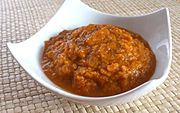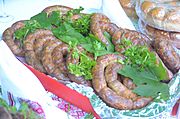Zakuski facts for kids
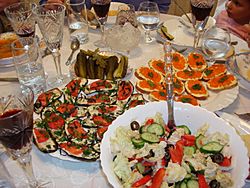 |
|
| Course | Hors d'oeuvre or snack |
|---|---|
| Place of origin | Eurasia |
| Region or state | Eastern Europe, Northern Europe, Asia |
| Main ingredients | Cold cuts, cured fishes, mixed salads, pickled vegetables, kholodets, pirozhki, hard cheeses, caviar, roe, canapés, open sandwiches, breads |
Zakuski (say "zah-KOOS-kee") is a collection of cold appetizers and snacks. These tasty dishes are popular in Russia and other Slavic countries. The word "zakuski" comes from the Russian word meaning "something to bite after."
Zakuski are often served as the first course of a big meal. They are also enjoyed as snacks on their own. This tradition likely started in early Russian regions like the Novgorod Republic. It was influenced by different cultures, including Slavic, Viking-Nordic, and Oriental traditions.
Contents
What Are Zakuski?
Zakuski are a special part of meals in many countries. They are not just small bites. They are often a whole course by themselves. Imagine a table full of different delicious foods to try!
A Rich History
The idea of zakuski is similar to the Swedish and Finnish brännvinsbord. This was an early version of the modern smörgåsbord. It also shares similarities with meze from the Ottoman Empire and other Middle Eastern cultures.
Unlike a buffet, zakuski are usually set out on the dining table. In the past, Russian noble families kept zakuski ready. This was for visitors who traveled long distances and might arrive at any time.
How Zakuski Are Served
At big parties and banquets, zakuski were often served in a separate room. Sometimes, they were on a special table in the dining room. Over time, this tradition spread to everyone. Even during Soviet times, zakuski remained popular. Because homes were smaller, they were served right on the dinner table. This made zakuski the exciting first course of any festive dinner.
Zakuski Today
Today, you can find zakuski at parties, dinners, and celebrations. They are common in countries that were once part of the Russian Empire. This includes many post-Soviet states and Poland.
A wide variety of zakuski is a standard first course at any big feast. Guests usually find the zakuski already laid out on the table when they come to eat. It's a wonderful way to start a meal!
What Foods Are in Zakuski?
Zakuski include many different kinds of foods. They are usually cold dishes. Here are some common examples:
- Cold cuts: Sliced meats like sausages.
- Cured fish: Fish that has been preserved, often salty or smoked.
- Mixed salads: Different kinds of salads, like Olivier salad.
- Kholodets: A savory meat jelly, often made with chicken or pork.
- Pirogs or pirozhki: Small baked buns filled with meat, vegetables, or fruit.
- Pickled vegetables: Vegetables preserved in vinegar or brine. This includes tomatoes, beets, cucumbers, sauerkraut, and pickled mushrooms.
- Deviled eggs: Hard-boiled eggs with a creamy yolk filling.
- Hard cheeses: Slices of firm cheese.
- Caviar: Salted fish eggs, often from sturgeon.
- Canapés: Small pieces of bread or crackers with toppings.
- Open sandwiches: Slices of bread with toppings, served open-faced.
- Breads: Various types of bread to go with the dishes.
Images for kids
-
Pickled cucumbers are a popular zakuska.
-
Pirozhki, pickled tomato, and mixed salads.
-
Kholodets is a meat jelly.
-
Olivier salad is a classic Russian salad.
-
Brined or pickled herring is often served.
-
Sauerkraut salad is made from fermented cabbage.
-
Dressed herring is a layered salad with herring and vegetables.
-
Breads with salo (cured pork fat).
-
Kolbasa (sausages) are a common cold cut.



